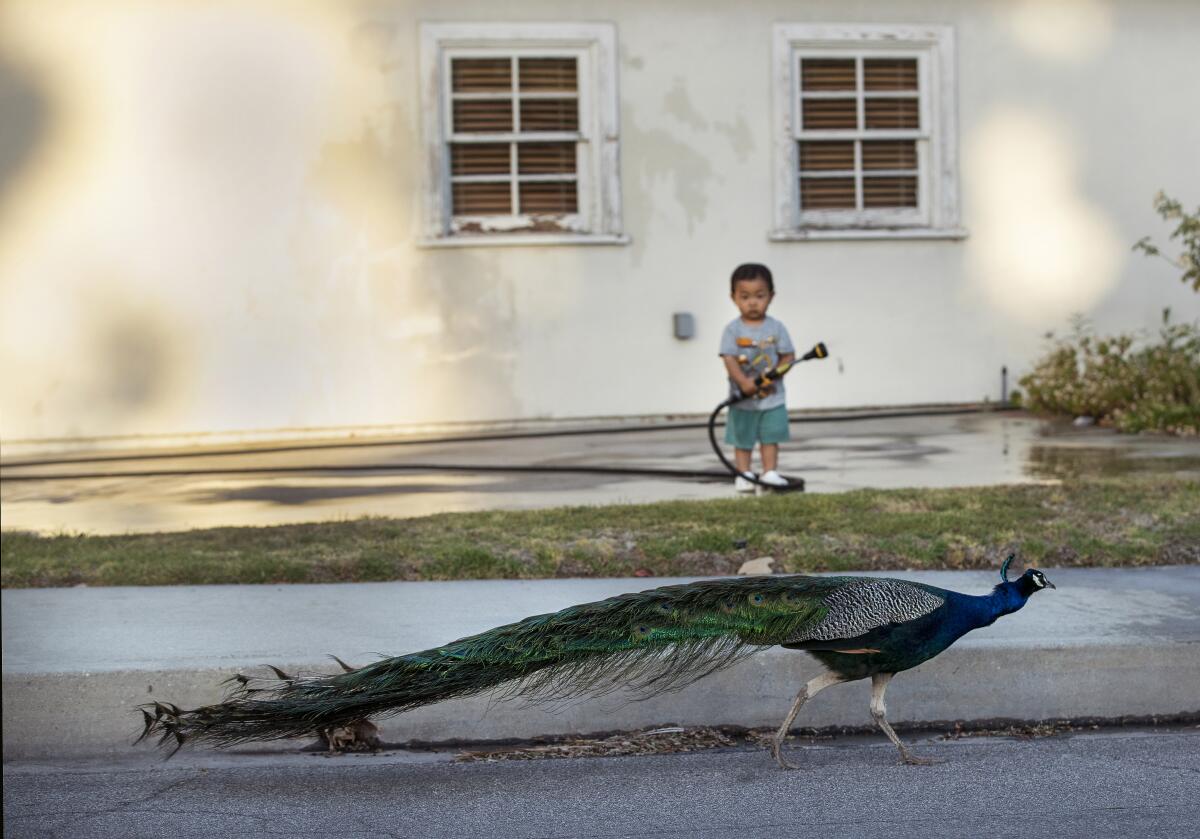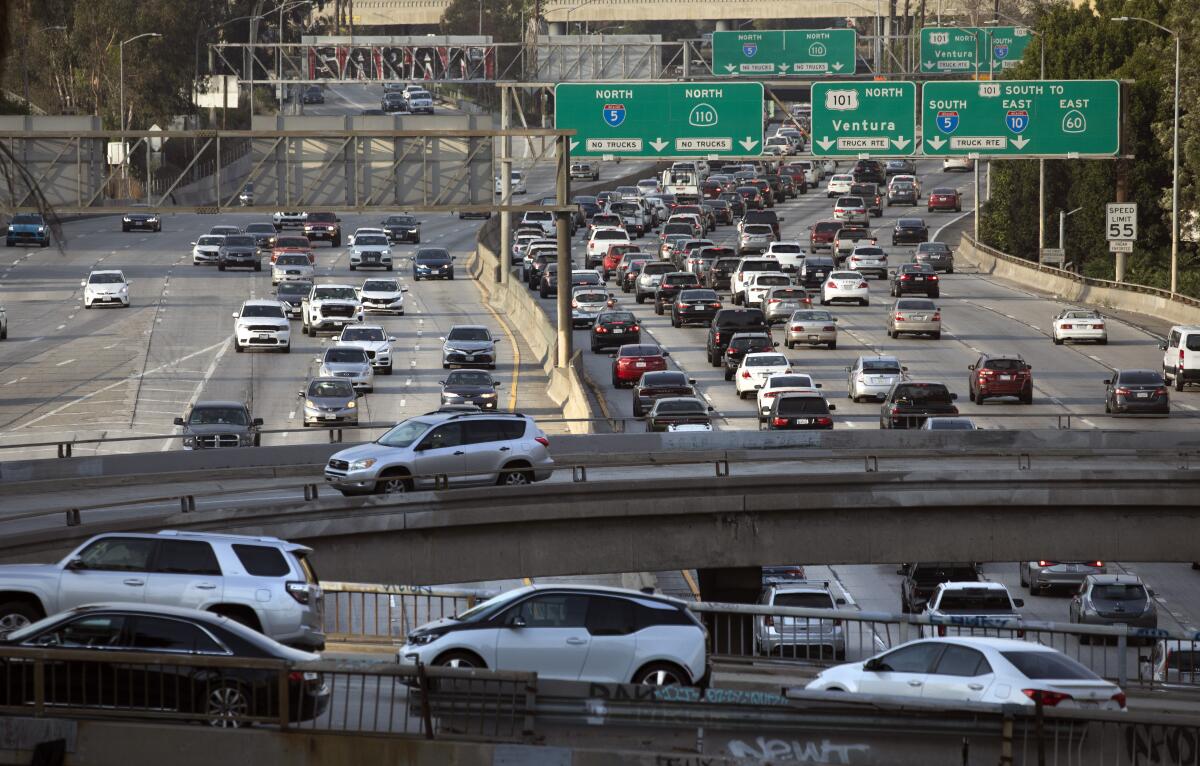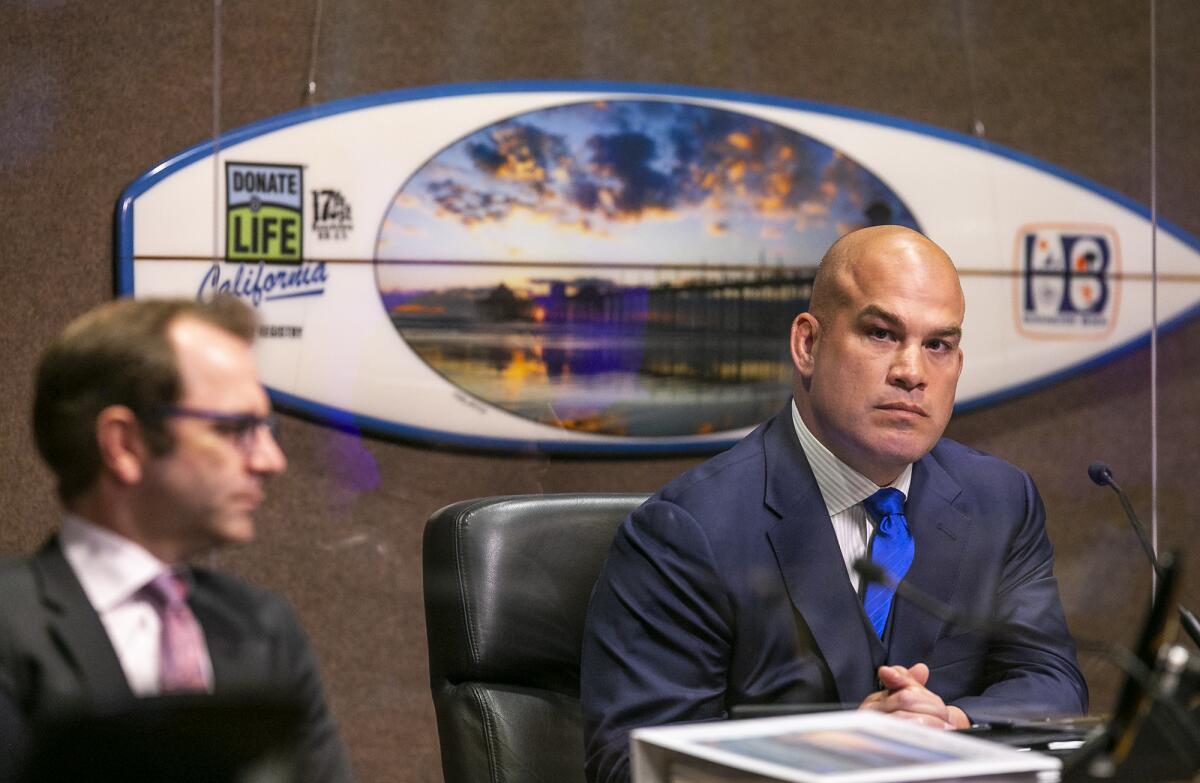L.A. County’s never-ending peafowl predicament

Good morning, and welcome to the Essential California newsletter. It’s Friday, June 18. I’m Jaclyn Cosgrove, reporting from a hot apartment in Los Angeles.
On a recent trip to the Los Angeles County Arboretum and Botanic Garden, I sat on the patio of the Peacock Cafe, eating my lunch of Thai noodles and fruit. A predator loomed nearby — a gray peahen who circled my table more than once.
She and the peacock staring at me from his perch 10 feet away were both optimistic that I would feed them. I declined.
I was there reporting on a story that published in The Times about how peafowl have become such a problem in the San Gabriel Valley that the L.A. County Board of Supervisors is moving to draft an ordinance banning feeding the fanciful fowl.
Sign up for Essential California
The most important California stories and recommendations in your inbox every morning.
You may occasionally receive promotional content from the Los Angeles Times.
It’s a topic that has pitted neighbor against neighbor. The pro-peafowl contingent argues that these birds are an important part of local culture, giving their communities color and splendor. The dissenters point to the damage that peafowl can do, wrecking gardens, pecking cars and pooping on roofs.
And then there’s the screeching.
In a 1950 article about the peafowl predicament in Arcadia — neighbors being angry about peafowl has been an issue for decades — resident Maude Garrity lived near the arboretum and nicely summed up the sound of the peacock.
“At night in our trees they are like not one, but a dozen, women and children being murdered,” she declared. “They hop down from our television antenna after practically wrecking it, and they land on our housetop like small ponies.”
Thanks to the mystical powers of the internet, you can hear the call yourself via this YouTube link.
When I first started reporting this story, I’ll be honest — I was curious about how aggressive a peafowl could really be if fed. My experience at the arboretum cafe showed me otherwise. Peafowl are the size of turkeys, with sharp beaks, massive talons and spurs that could gouge you.
Supervisor Kathryn Barger, who led the initiative to ban feeding, told me the main reason she wants to do so is because several residents have reached out to her, angry about the birds and the problems that ensue when their neighbors feed them.
“They can become very territorial and very hostile, and their beaks are painful,” Barger said.
The California Department of Fish and Wildlife has tried for years to educate the public about the dangers of feeding wildlife.
I spoke with wildlife biologist Rebecca Barboza, who has been with the department for 21 years. In her two decades working in Southern California, she has seen people, and animals, get hurt because of feeding.
Years ago, a man in one of the foothill communities would throw a slab of bacon out in the street for a bear. The man wanted to get pictures, Barboza said.
Most people, though, are well intentioned and think they’re helping. “But after a while, animals start to expect food from every two-legged animal walking around,” she said.
Then there’s the harm that can come to the animals by feeding them human food.
At Catalina Island, there’s a significant issue with feeding the deer around Avalon, she said. Deer come by and eat produce, cat food and other grub that humans leave, but because of their complex digestive systems, they cannot digest any of it.
“They’re actually starving to death,” Barboza said, noting the food passes through their bodies, offering them no nutritional value.
Meanwhile, in the San Gabriel Valley and Palos Verdes Peninsula, officials say peafowl have thrived for years without humans feeding them. The supervisors will most likely pass the ordinance when it comes before them in a few months.
Barger thinks the peafowl will be just fine.
“People are going to do what they want to do, but I think that we need to educate them as to why it’s not appropriate, and in part and parcel, it is because they already can fend for themselves, and it’s creating a larger population that is breeding, and it is impacting the communities,” Barger said.
And now, here’s what’s happening across California:
New mask standards. California’s circuitous journey to relaxing coronavirus-related workplace safety rules finally reached its destination Thursday, when the state moved to end physical distancing requirements for all workers and to allow most fully vaccinated employees in many workplaces to stop wearing masks. Los Angeles Times
Note: Some of the sites we link to may limit the number of stories you can access without subscribing.
L.A. STORIES
Traffic is back, but different. As Los Angeles reopens, those seemingly unbelievable ribbons of green on your phone’s freeway traffic app are rapidly returning to red. Few now believe the wildest predictions of 2020 will come to pass: that the coronavirus would disrupt L.A.’s notorious traffic once and for all. But changes in behavior and economics — including work, school and leisure travel — could determine the new normal. (This story is a Times subscriber exclusive) Los Angeles Times

'The Times' podcast
Our new weekday podcast, hosted by columnist Gustavo Arellano, takes listeners beyond the headlines. Subscribe on Apple Podcasts and follow on Spotify.
THE CORONAVIRUS
A debate to vaccinate. From the earliest days of the pandemic, doctors and public health officials have seen widespread vaccination as the most effective way to stop COVID-19 in its tracks. But a growing contingent of medical experts is now questioning whether the conventional wisdom should apply to children. Los Angeles Times
POLITICS AND GOVERNMENT
Gavin’s got green. The fundraising gap between Gov. Gavin Newsom and his main GOP challengers has become a quickly growing chasm. Newsom has raised almost $16.5 million to defend himself in the recall contest expected this fall, about twice as much as his entire field of Republican challengers combined. San Francisco Chronicle
A losing fight. The political career of Tito Ortiz in Huntington Beach was short and flashy, ending earlier this month. His approach to public office shows what’s wrong with today’s politics. Los Angeles Times

County supervisor enters treatment. San Francisco Supervisor Aaron Peskin issued an emotional apology for his past behavior and expressed remorse for his conduct at Tuesday’s board meeting, days after he announced plans to enter alcohol treatment. His announcement and apology came after the San Francisco Chronicle interviewed more than two dozen people who reported the supervisor using profane language in private conversations and appearing intoxicated in public and private meetings. San Francisco Chronicle
CRIME AND COURTS
Record force. Bakersfield police officers used force that broke at least 45 bones in 31 people between 2016 and 2019, according to an analysis of public records by the California Reporting Project. The city of Bakersfield released the documents under a recent California law that increases transparency in policing. Bakersfield Californian
Support our journalism
CALIFORNIA CULTURE
A blond bombshell. Local leaders in Palm Springs are gearing up to celebrate the unveiling of “Forever Marilyn,” a 26-foot statue of Marilyn Monroe in her iconic windy white dress pose. Opponents have planned a protest at the site of the massive statue in downtown Palm Springs, with some arguing it is misogynistic and antithetical to Palm Springs’ values. Desert Sun
Flying chicken. Costa Mesa-based chain El Pollo Loco will start testing a drone this week in Orange County that can airlift fast food into people’s backyards. The food chain is in the process of choosing as many as 10 restaurants to participate but could expand to more if all goes well. Orange County Register
A history of pride. Considered a gay-friendly destination with an established LGBTQ community, Sonoma County is a place where pride flags are displayed prominently in downtown plazas, businesses and schools. But the journey for Pride Week to be officially recognized was an uphill battle. Santa Rosa Press Democrat
Free online games
Get our free daily crossword puzzle, sudoku, word search and arcade games in our new game center at latimes.com/games.
CALIFORNIA ALMANAC
Los Angeles: Sunny, 84. San Diego: Partly cloudy, 75. San Francisco: Sunny, 72. San Jose: Sunny, 91. Fresno: Partly cloudy, 111. Sacramento: Sunny, 108.
AND FINALLY
Today’s California memory comes from David Otott:
I was 14 years old in the summer of 1970 when our family of seven arrived at our new home in Fountain Valley after driving nearly 3,000 miles from Virginia in our great, big Pontiac station wagon (I can still remember it costing $6.50 to fill the tank). At that time much of Fountain Valley was still covered by strawberry fields, though within just a few years all of those strawberry fields were gone ... replaced by mile after mile of monotonous tract housing. Brings to mind the lovely old Beatles song “Strawberry Fields Forever.” Sadly, not in Orange County.
If you have a memory or story about the Golden State, share it with us. (Please keep your story to 100 words.)
Please let us know what we can do to make this newsletter more useful to you. Send comments to essentialcalifornia@latimes.com.
Sign up for Essential California
The most important California stories and recommendations in your inbox every morning.
You may occasionally receive promotional content from the Los Angeles Times.



